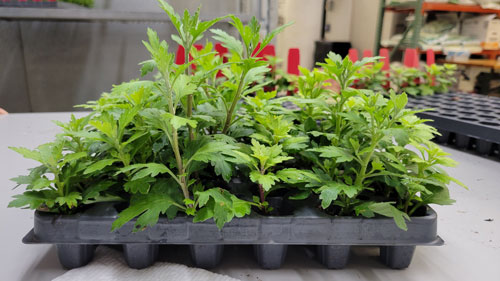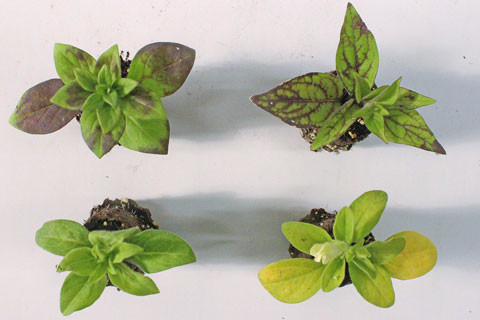11/1/2022
Optimize Rooting Uniformity: A Hierarchical Process
Bill Calkins

For greenhouses rooting large numbers of cuttings or growers interested in processes to improve rooting success, it’s critical to look at the key limiting factors to producing high-quality rooted liners. This is a very scientific process that involves multiple factors of plant growth—hydration, light, temperature, nutrition and gas exchange. Ball Horticultural technical experts Drs. Will Healy and Nathan Jahnke have been researching best management practices related to URC production and recently shared their research-based strategies in a high-level floriculture conference, which is currently being developed into a video series.
Pictured: Young plants are grown at high density, limiting CO2 within the plant canopy.
Total moisture control
Hydration is highly critical when sticking and rooting vegetative cuttings. The bottom line is that dehydrated cuttings root non-uniformly and this leads to a seemingly endless array of problems down the production path. Right from the start, at the farm of origin, hydration can be variable, so your task as a propagator is to bring URCs up to a level of hydration required for sticking.
Post-harvest handling must be a priority because, according to Will and Nathan, holding and shipping conditions can make a big difference in plant quality from the get-go. This is why many cuttings are wrapped in moist paper during shipping in the hopes of decreasing the amount of water lost from the cuttings. Understanding transport conditions goes a long way in creating the best environments for your young plants from the start.
Once cuttings are out of the box, rehydration is often necessary. There’s been a lot of new research into rehydration needs and strategies. Will explains that pre-cooling has shown a lot of positive results, but attention needs to be paid to the dehydration effects of coolers.
“Refrigeration is by nature a dehumidification process,” he says. “It creates an environment of very high vapor pressure deficit (VPD), which dries out the plants.”
A general misting strategy for the early stages of production (Stage 1 to 3) is as follows, according to Will and Nathan:
Stage 1: Create turgidity from day 0 to about 3 by keeping the trays irrigated to a Level 4.
Stage 2: Trigger callus formation from about day 4 to 7 wetting to Level 4 and drying down to Level 3.
Stage 3: Drive root development from about day 7 to 21 by irrigating to a Level 4 and drying down to a Level 2.
Daily light integral
Plants require light to photosynthesize (we know this) and photosynthesis drives carbohydrate production and healthy growth. Nathan explains that the most important aspect of lighting is the daily light integral (DLI), which is the total amount of light plants accumulate over time because it increases carbohydrate production.
“Increased carbohydrates promote callus and root development,” Nathan says. And on the flip side, carbohydrates, and thus optimal growing conditions, are depleted when post-harvest conditions are substandard. Stock plant production has improved greatly in recent years, but nonetheless, the quality of plants coming in must be monitored in order to get off to a strong start.
“When we increase light during young plant production, we really get improved root production,” he says. “And why? Because when we increase carbohydrate production in the leaves, it transfers down to the stem base and improves rooting.”
University research at Michigan State and Purdue has confirmed this and shown that a DLI of more than 6 mols per day can drastically reduce the time it takes a cutting to develop roots.
However, it’s not a good idea to ramp up the light right away or you run the risk of damage. When cuttings are first stuck, the DLI should be increased gradually over time (from a shaded start) in order to acclimate the plants, Nathan says. “Get a light meter. It will be a great investment for your operation.”
 Pictured: URCs arriving at your greenhouse are often deficient in phosphorous. If it’s not quickly applied after stick, you might see purpling in the foliage, especially on petunia, calibrachoa and verbena.
Pictured: URCs arriving at your greenhouse are often deficient in phosphorous. If it’s not quickly applied after stick, you might see purpling in the foliage, especially on petunia, calibrachoa and verbena.
Current research is also looking more and more into light quality, as this dictates the photomorphogenesis of a plant. It’s a big word that basically means how you control the overall growth, shape and structure of the plants you grow. LED lighting has a lot to do with the need for energy efficiency, Nathan says, but they also can have a great impact on plant growth and quality in production. LED research is ongoing, and much is being learned currently about specific light spectrums as it relates to photomorphogenesis control.
Nathan explains that certain spectrums can lead to many benefits, including reduced plant growth regulator use because plants grown under carefully selected light spectrums show shorter internodes and petioles, as well as enhanced pigmentation.
“What we want to produce, at the end of the day, is a liner that’s more compact and resilient to shipping and even automated transplanting in the future,” Nathan explains. “Something that looks aesthetically pleasing and healthy to customers going out the door.”
Degree day
Temperature controls the rate of plant development in all stages, especially young plant production. Current trends in young plant production consider more than just the temperature in the greenhouse or in growing media, many growers measure a factor called growing degree-days. It’s actually a common tool in fruit and vegetable industries, and is also very effective when producing floriculture crops.
Will explains this is the measure of temperature above a base temperature, where plants just don’t grow because it’s too cold. These base temperatures vary by species.
“As you increase temperature, you increase respiration,” he says. “The more respiration, the more plants grow. And so the more degree days, the more they grow.”
This increased respiration and subsequent growth is great when you’re producing larger plants, but in the case of young plants, very rapid growth leads to a variety of challenges because the cuttings are photosynthesizing as much as when they’re larger. Challenges include lack of water uptake, nutritional disorders and other problems, Will says.
Research has been done to identify the respiration of cuttings of different plant species at different temperatures in dark storage. This helps harvesters at farms determine when in the day is optimal for taking cuttings and packaging them for shipment. It’s been important in postharvest handling, as well as creating guidelines for growers receiving cuttings and handling them prior to sticking to reduce respiration after shipping stress.
Research into degree days has also resulted in more effective protocols for storing and cooling cuttings, as well as managing optimum rooting temperatures.
“Maintaining an optimum soil temperature enhances callus proliferations and allows root penetration,” Will says. “It promotes rapid root development.”
As a rule of thumb, he says, somewhere around 75F (23C) is the ideal temperature for the root. Be sure to use your infrared thermometer or soil probe to accurately measure soil temperature, especially during the winter because heating your greenhouse actually reduces air moisture and can cool soil temperature and roots.
Basic nutrient level
On production farms, cuttings can be harvested every four to six weeks and this just isn’t enough time for the tissue to take up enough macro- or micro-nutrients. For example, nitrogen is taken up quickly and cuttings are rarely deficient in this nutrient, Will says. However, phosphorous is generally restricted by stock plant growers to reduce stretching. So when you stick cuttings and don’t quickly apply phosphorous, this is when you’ll see purpling indicating a deficiency, especially on crops like petunias, calibrachoa and verbena, he explains.
Other nutrient deficiencies you need to watch out for in early stages of production are calcium and boron. Low transpiration in humid young plant greenhouses often limits the uptake of these nutrients.
“Remember you need to keep drying these plants out,” Will says. “It shouldn’t be a swamp in your propagation houses. If you walk in and feel the humidity … it’s too humid.”
Similarly, when soil is too wet in propagation, nutrient availability is reduced and uptake is limited.
Will’s final point on cuttings nutrition is a warning about an oft-misidentified deficiency when cuttings appear yellow. Many growers immediately suspect iron deficiency, but this is rarely an issue in young plant production. Rather, according to Will, it’s most likely manganese. When you get manganese to the correct levels, plants quickly start growing more rapidly.
Gas exchange
The final potential limiting factor in optimal cuttings production is gas exchange, specifically CO2 levels in the plant canopy, and according to Will and Nathan, it’s the one that’s lacking enough current research. In stock plant facilities, plants are grown at a very high density, and this limits airflow and air exchange. There’s just not enough CO2 getting in the plant canopy to help the plants create carbohydrates, Will says. The same is the case for cuttings production, where plants in liner trays are grown very close together.
Some possible tactics to combat this negative impact include CO2 injection and increasing air exchange by generating some “turbulence” using vertical fans, not just horizontal fans.
“You want the leaves to flutter a little bit under fans because that means you’re driving air and CO2 in there,” Will says. “CO2 is the gasoline that drives this car.”
Both Will and Nathan agree that this area of cuttings production deserves additional research very soon because there are a lot of opportunities to improve processes for offshore producers and rooting stations. GT
Click the link to check out the full video playlist on YouTube. In each episode, you’ll find detailed graphs, charts and images of cuttings to help your entire production team stay up-to-date on the latest strategies to optimize cuttings production, reduce shrink and increase efficiency. https://youtube.com/playlist?list=PL8NX3KFjAfBkUFpE72nX37ByIG9mjqg_o